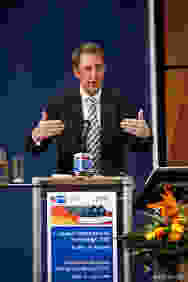
According to the Berliner Zeitung, the head of Germany’s energy agency DENA is warning that there is a real danger that solar power, could crash Gemany’s ageing electricity grid.
The problem is the amount of electricity produced by solar panels varies according to location, time of year, time of day and cloud cover. They are most productive when the sun emerges, which you will not be amazed to learn, is during daylight hours. But that is when demand for electricity is lowest.
As a consequence there can be huge power surges as tens or hundreds of thousands of small solar installations export their surpluses back to the grid.

While small power surges can be dealt with by switching off local power stations, the amount of solar capacity in Germany will soon be so large thanks to generous subsidies, that under certain conditions, electricity supply could exceed demand, even with all Germany’s power stations switched off.
The result says Stephan Köhler, head of Germany’s energy agency, DENA, is that solar capacity will soon be so large that solar surges could trigger blackouts.
The possibilty of solar-created power outages is a tribute to the success of German energy policy. Subsidies have been so successful in encouraging German citizens and businesses to install solar panels and sell surplus electricity to the grid at a premium, that solar now accounts for 15 per cent of generating capacity in Germany.
According to figures provided by from the energycollective there are currently about 700,000 grid-connected PV solar systems with a total capacity of 14,680 MW installed by German households and businesses. DENA says that at the current rate solar capacity could reach 30 gigawatts by the end of next year -equal to the country’s weekend power consumption,. “We need to cap installation of new panels,” concluded a Dena spokesperson .
The German Solar Industry Federation rejected DENA’s argument, claiming that extra solar energy takes the pressure off high-voltage power lines because it tends to be generated close to where it is used. The federation adds that the grid only needs to be strengthened in some rural areas where solar supply can exceed demand.
Germany’s problems highlight an hitherto unforeseen peril of moving to renewables without adequate preparation. “You lose flexibility on the supply side, so you need to gain some on the demand side,” said Tim Green of Imperial College London,”perhaps by encouraging people to charge their electric cars when the sun shines.”
UK based New Scientist magazine quoted Tim Nuthall of the European Climate Foundation in Belgium as arguing that Germany’s experience makes the case for a transcontinental grid. “The best long-term solution is to install region-wide grids, he said. “In Europe, you need a grid that balances the sun in the south with the wind in the north.”
Maybe. But we cant help thinking that a quicker, cheaper approach would be for micro-generators to be on some kind of trip switch which would be operated whenever it looked like supply was going to exceed demand. Batteries, hot water or other devices could be used to store the unused energy. ENDS
One Response
Doubtlessly Solar is a Natures Gift,But how about Getting Torque Current from Batteries,need to have a very large battery bank.Is it not.